If you’ve ever worked with APIs, you probably know how tricky it can be to get the right data. With REST, you often have to call different endpoints and still end up with either too much or too little information. It can slow things down and make things harder than they need to be. That’s where GraphQL helps. It gives you a smarter way to ask for exactly what you need in one go—making web apps faster and easier to build.
Web apps today do more than just show information on a screen. They connect users to real-time updates, power smart features, and support hundreds of devices. Behind all that is one simple idea: data needs to travel between systems. And that’s where APIs come in.
For a long time, developers relied on REST APIs to make this work. But things have changed. Today’s web apps need quicker responses, more flexible ways to access data, and fewer calls going back and forth to the server. That’s exactly why GraphQL is getting popular—and is quickly becoming the new go-to choice.
Now, you might be wondering — what makes GraphQL so special? Why are businesses of all sizes turning to it? And how does it fit into the world of API-Driven Web App Development?
Let’s break it down and talk about it in a simple way!
What is GraphQL?
GraphQL is a way for your app to ask a question and get exactly the answer it wants. Nothing more, nothing less.
In more technical terms, GraphQL is a way to request and deliver data between the front-end (the part of an app users see) and the back-end (the server and database). It was created by Facebook and is now open-source — meaning anyone can use it freely.
How GraphQL is Different from Traditional APIs (Like REST)
Before GraphQL became popular, most web apps used REST APIs. These worked just fine for years. But as apps became more complex and users expected faster and smarter interfaces, REST started to show its limits.
Here’s why GraphQL stands out:
- Only one endpoint needed: With REST, you usually need multiple URLs (endpoints) to get different sets of data. GraphQL uses a single URL to access everything.
- Saves data and time: Apps can ask for exactly what they need, which avoids overloading the user with unnecessary data.
- Works well for modern apps: Today’s apps are often rich in visuals, content, and real-time updates. GraphQL fits well into that style of development.
This approach has become a key part of what’s known as Modern API Architecture — a more efficient and scalable way to build applications.
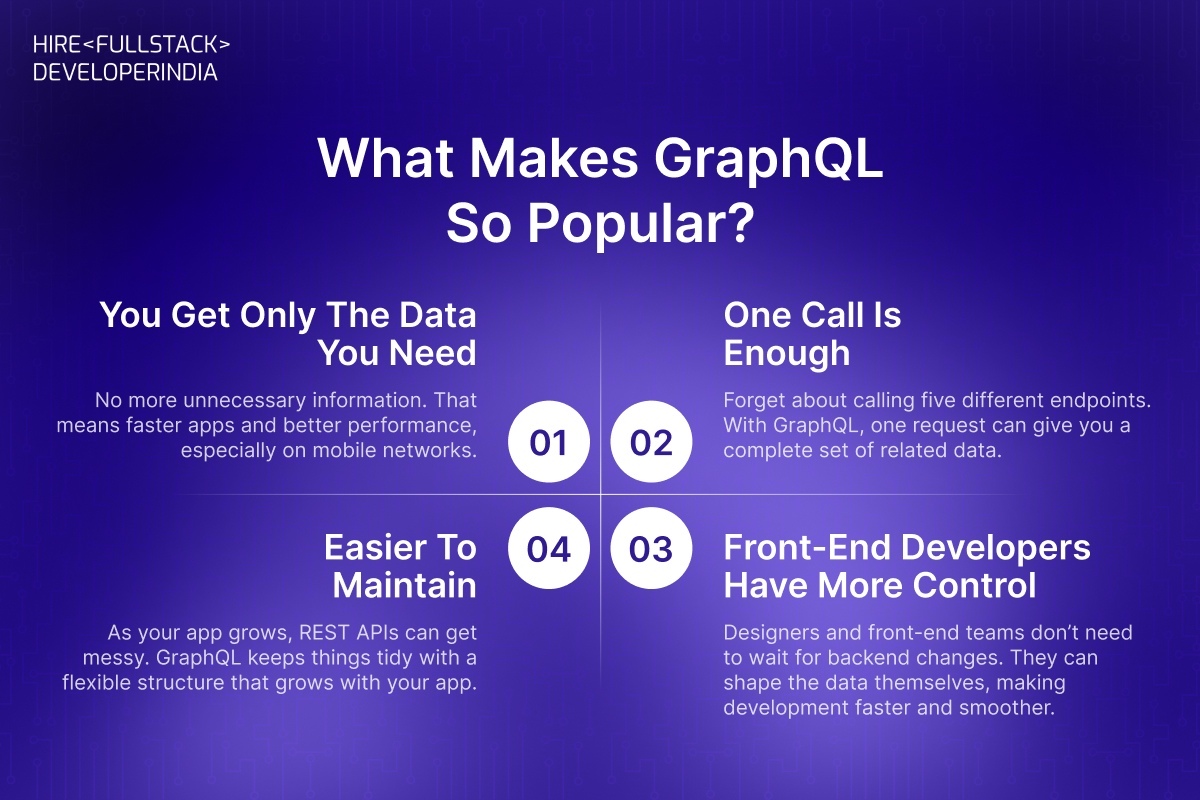
What Makes GraphQL So Popular?
Let’s walk through a few reasons that are easy to relate to:
- You get only the data you need: No more unnecessary information. That means faster apps and better performance, especially on mobile networks.
- One call is enough: Forget about calling five different endpoints. With GraphQL, one request can give you a complete set of related data.
- Front-end developers have more control: Designers and front-end teams don’t need to wait for backend changes. They can shape the data themselves, making development faster and smoother.
- Easier to maintain: As your app grows, REST APIs can get messy. GraphQL keeps things tidy with a flexible structure that grows with your app.
Developers Love It Too
From a developer’s perspective, GraphQL offers something they often crave — control.
With REST APIs, developers sometimes feel like they’re forced to fetch extra information they don’t need or build workarounds to get data from multiple places. With GraphQL, they write clear queries asking for exactly what they want. It’s neat, simple, and efficient.
This shift has led to more companies offering GraphQL Development Services — helping other businesses switch to or start using GraphQL for their projects.
Why Businesses are Making the Switch
Businesses care about two things: speed and user satisfaction. GraphQL checks both boxes.
When apps load quickly, users are happy. When features can be added easily, the business can keep growing without major delays or technical hiccups.
Many teams working on API-Driven Web App Development now prefer GraphQL as their main tool — not just because it’s trendy, but because it actually helps build better, faster, and smarter apps.
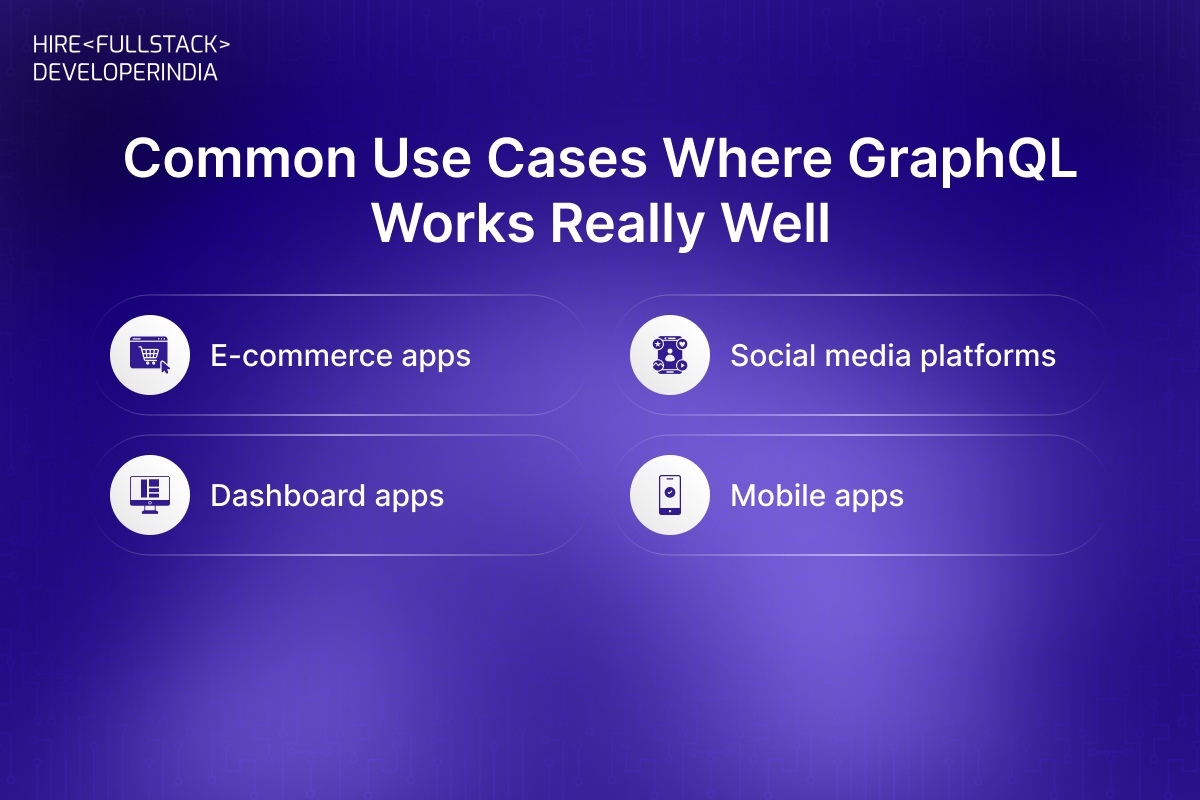
Common Use Cases Where GraphQL Works Really Well
Here are a few types of apps that benefit most from GraphQL:
- E-commerce apps: Where you need to show product details, user reviews, stock info, and payment options — all in one view.
- Social media platforms: With user posts, likes, comments, profile details, and more.
- Dashboard apps: That pull information from many data sources at once (e.g., marketing analytics or sales reports).
- Mobile apps: Where data needs to be minimized to ensure speed and battery efficiency.
Easy Integration with Front-End Frameworks
GraphQL works really well with popular front-end tools like React, Vue, and Angular. That means developers don’t have to change their entire workflow — they can simply plug GraphQL into what they’re already using.
This flexibility is another reason why GraphQL Development Services are in demand today. Whether someone is building a brand new app or improving an old one, GraphQL fits right in without causing headaches.
Better Developer and Team Collaboration
One cool thing about GraphQL is that it encourages better teamwork.
Here’s how: developers can look at the GraphQL schema (kind of like a map of available data) and understand what’s available and how to use it — without needing to ask back-end teams for details constantly.
This makes collaboration smoother and helps teams deliver faster — especially in fast-paced projects like API-Driven Web App Development.
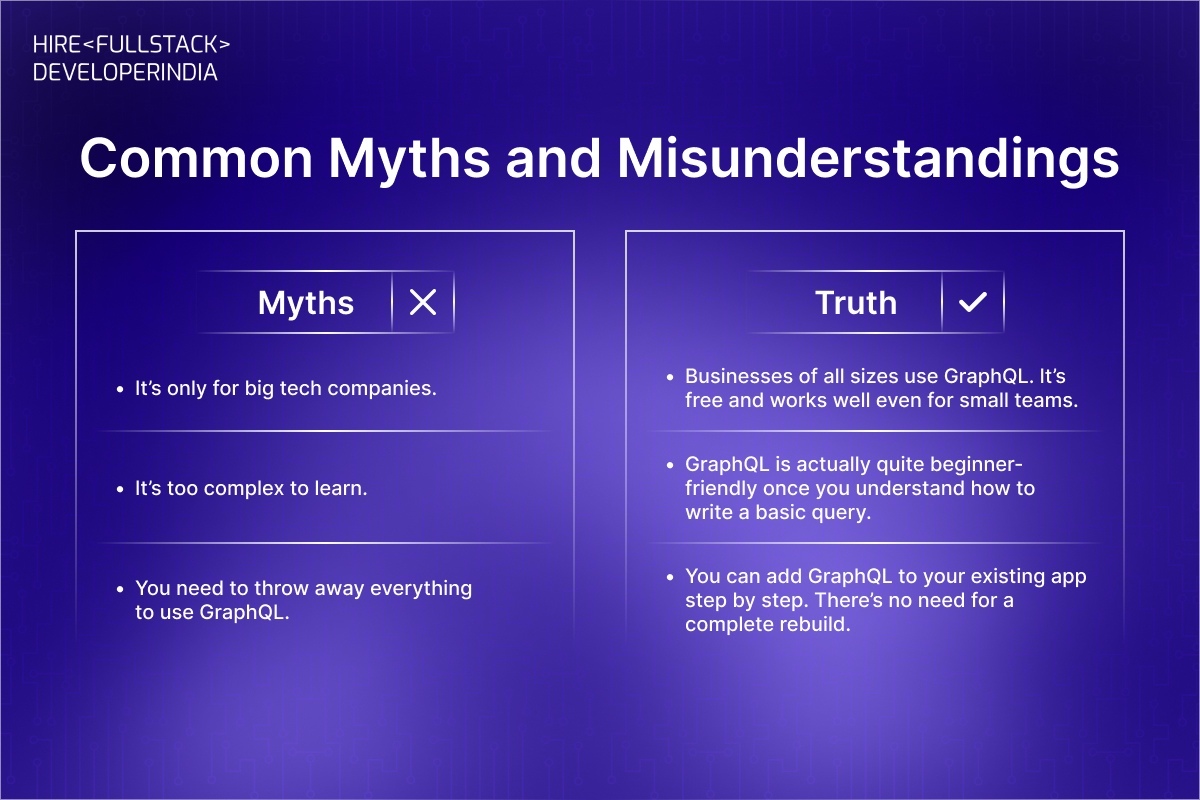
Common Myths and Misunderstandings
Like any popular technology, GraphQL comes with its fair share of myths. Let’s clear up a few:
Myth: “It’s only for big tech companies.”
Truth: Businesses of all sizes use GraphQL. It’s free and works well even for small teams.
Myth: “It’s too complex to learn.”
Truth: GraphQL is actually quite beginner-friendly once you understand how to write a basic query.
Myth: “You need to throw away everything to use GraphQL.”
Truth: You can add GraphQL to your existing app step by step. There’s no need for a complete rebuild.
These misunderstandings often stop companies from exploring GraphQL API Development, even though it could solve many of their data and performance issues.
Why GraphQL is Part of the Future of APIs
We’re heading into a time where apps are becoming smarter, users expect fast experiences, and businesses want to keep launching new features without wasting months on development.
In this kind of environment, tools that offer flexibility, speed, and ease-of-use naturally stand out. That’s what makes GraphQL a key part of Modern API Architecture.
More and more companies are starting to see GraphQL as not just a nice-to-have tool, but a must-have for building serious apps.
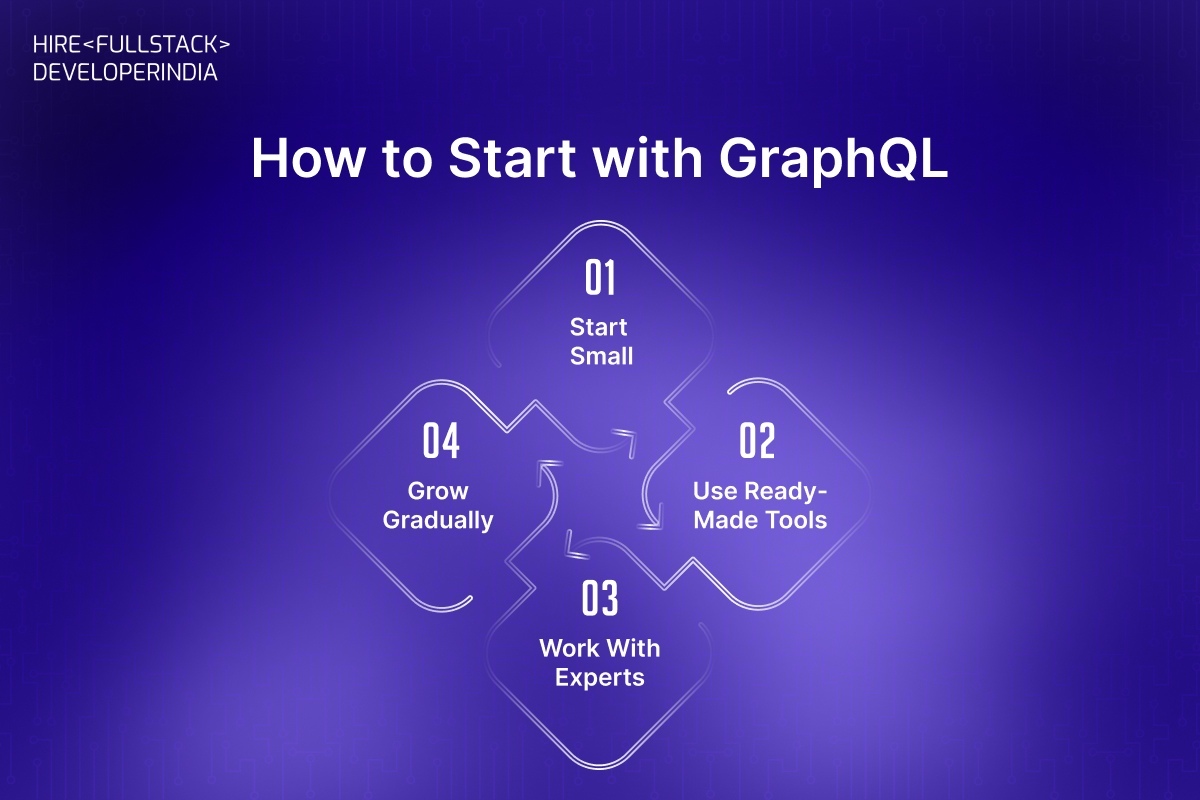
How to Start with GraphQL
If you’re thinking about building an app or improving an existing one, here’s a simple path forward:
- Start small – Use GraphQL for one section of your app.
- Use ready-made tools – There are many beginner-friendly tools that make using GraphQL easier.
- Work with experts – Teams that offer GraphQL Development Services can guide you through the setup, design, and best practices.
- Grow gradually – As you get comfortable, you can expand GraphQL usage across your project.
The great part is, there’s no need to rush or feel overwhelmed. GraphQL can grow with your app.
The Role of GraphQL Development Services
While GraphQL sounds simple on the surface, setting it up right takes experience. That’s where GraphQL Development Services come into play.
These expert teams help you:
- Plan your API structure
- Connect GraphQL to your existing systems
- Keep performance high and response times low
- Maintain a secure and scalable setup
Instead of reinventing the wheel, many businesses now turn to these services to fast-track their projects. It saves time, avoids technical mistakes, and ensures your API backbone is strong.
When you work with a team that specializes in GraphQL API Development, you also get access to best practices that reduce bugs, make testing easier, and keep your app ready for the future.
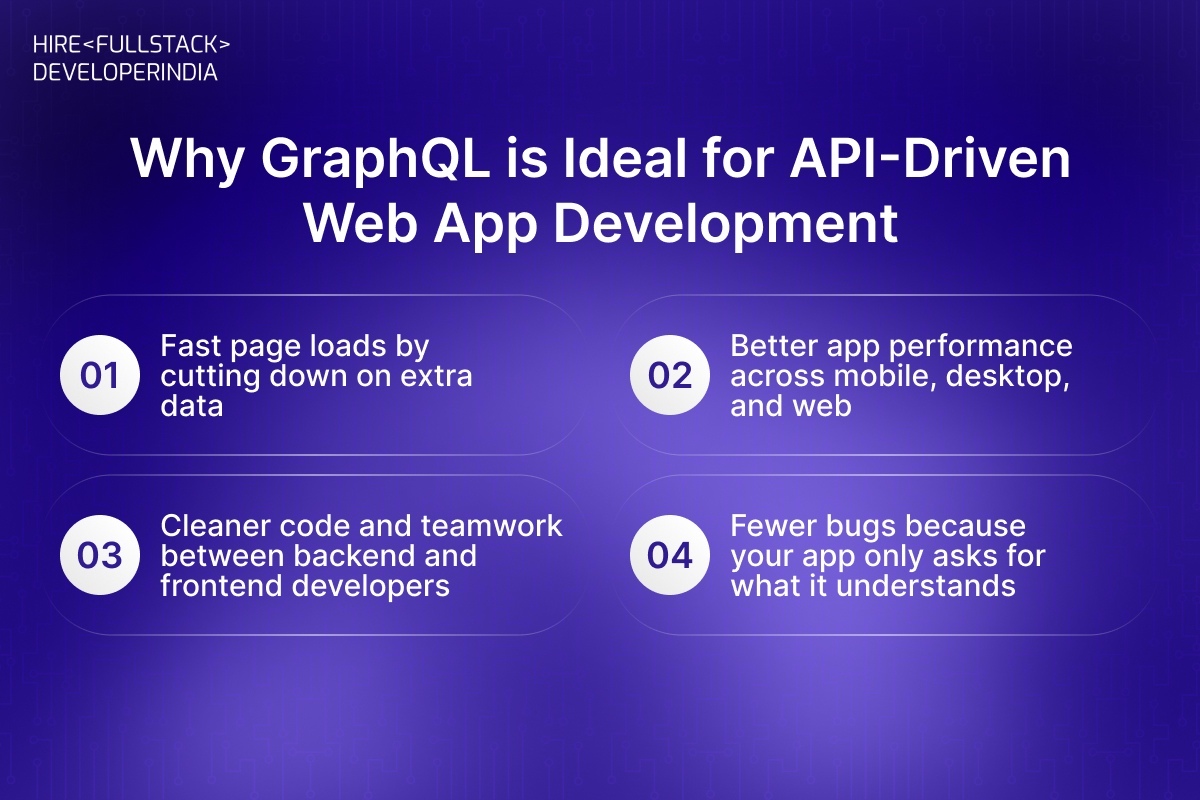
Why GraphQL is Ideal for API-Driven Web App Development
Let’s bring it all together.
Modern apps are fast, smart, and work across devices. They need a smart way to talk to data sources. That’s exactly what GraphQL offers.
It supports:
- Fast page loads by cutting down on extra data
- Better app performance across mobile, desktop, and web
- Cleaner code and teamwork between backend and frontend developers
- Fewer bugs because your app only asks for what it understands
All these things make GraphQL the perfect match for API-Driven Web App Development.
Whether you're building a single-page app or a large-scale platform, GraphQL gives your project the speed and structure it needs to succeed.
Getting Started: What You Can Do Next
Interested in trying GraphQL? Here’s how to begin without getting overwhelmed:
- Learn the basics: Understand how queries and schemas work. There are plenty of beginner-friendly tutorials out there.
- Use tools like Apollo or Hasura: These make GraphQL even easier to set up.
- Talk to a GraphQL Development Services team: If you want to move fast or build something big, this can make the process smoother.
- Start small: You don’t have to rebuild everything. You can add GraphQL alongside your current system.
With the right guidance and tools, any developer or business can benefit from what GraphQL has to offer.
Conclusion
GraphQL is becoming the go-to choice for developers who want clean, efficient, and flexible APIs. It fits perfectly with how modern web apps work, offering speed, precision, and ease of use.
As more businesses move toward Modern API Architecture and API-Driven Web App Development, the need for smart data communication tools keeps growing. GraphQL answers that need in a way that feels natural and manageable. Whether you’re building a new app or improving an old one, working with experienced GraphQL API Development professionals can help you unlock the full potential of your project.
The future of APIs is already here. And more often than not, it speaks GraphQL.


